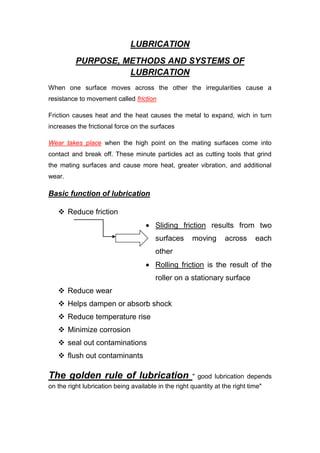
MET 105 Module 3
- 1. LUBRICATION PURPOSE, METHODS AND SYSTEMS OF LUBRICATION When one surface moves across the other the irregularities cause a resistance to movement called friction Friction causes heat and the heat causes the metal to expand, wich in turn increases the frictional force on the surfaces Wear takes place when the high point on the mating surfaces come into contact and break off. These minute particles act as cutting tools that grind the mating surfaces and cause more heat, greater vibration, and additional wear. Basic function of lubrication Reduce friction Sliding friction results from two surfaces moving across each other Rolling friction is the result of the roller on a stationary surface Reduce wear Helps dampen or absorb shock Reduce temperature rise Minimize corrosion seal out contaminations flush out contaminants The golden rule of lubrication " good lubrication depends on the right lubrication being available in the right quantity at the right time"
- 2. Basic principles governing the application of lubricants cleanliness is vital (lubricating equipment must be kept free of dirt and other contaminants before changing lubricant the equipment should be cleaned out an excess of lubricant especially grease will cause excessive heat to build up and eventual breakdown of the lubricant Lubricant filters should always be changed at the recommended time Inadequate lubrication can often be identified by the operating condition of a bearing Lubricants are potentially hazardous materials and should be stored with regard to safety effect on the environment basic methods of lubricants 1-Manual application Oil can for liquid lubricant Grease gun for grease Brush or spray gun for solid lubricant 2-Gravity (dripping) (drip-feed oiling) Only for liquid lubricants 3- Splash and bath lubrication The components requiring lubrication being partially immersed in an oil sump so that they pick up oil as they rotate
- 3. 4- Pressure lubrication When the operating speeds are high the equipment require a pressurized system to ensure that an adequate supply of lubricant can be determined 5- Automatic lubrication The automatic lubricators are the single-point small reservoir units that mount on the bearing in place of grease fitting and dispense the correct amount of grease to bearings as needed 6- Centralized automatic lubrication systems Basic types of lubricant 1. Liquid 2. Semi-solid or plastic 3. Solid 4. Gaseous Source of lubricant Animal Vegetable Mineral
- 4. Criteria for measuring the properties of oils Viscosity (thickness of a fluid and is also described as resistance to flow) Viscosity index (rate of change of viscosity with temperature) Flash point (temperature at which the vapor of lubricant will ignite Fire point ( the temperature at the vapor will ignite) Pore point ( low temperature at which the lubricant becomes so thick it ceases to flow) Oxidation resistance ( at increased temperature they tend to absorb oxygen) Criteria for measuring the properties of greases Hardness Dropping point (temperature at which grease will change to liquid) Pumpability (a measure which grease will flow through a system) Water resistance (determine whether or not grease will dissolve in water Stability (determines the ability of grease to retain its characteristics)
- 5. Types of liquid lubricants (oils) Circulating oils Gear oils (required to have high viscosity) Machine and engine oils (commonly used on plain bearing and slides ways) Spindle oils (high quality oils used for sensitive equipment) Refrigeration oils (for refrigeration equipments) Steam cylinder oils Special purpose oils General purpose oils (multi viscosity or multi grad specifications) GREASES Categories of greases Calcium based Sodium based Barium based Lithium based Aluminum based Complex Mixed based Mineral oils mixed with solids Applications of greases Way and slides Plain bearing greases Rolling element bearing
- 6. Solid lubricants Solid lubricant such as graphite and molybdenum Additives To improve lubricant properties Types of additives Oxidation inhibitors (prevent the chemical breakdown) Detergents and dispersants (keep surfaces clean ) Rust and corrosion inhibitors (prevent formation of rust) Pour point depressants (to ensure that the lubricant will maintain its ability to flow at low temperature Viscosity index improvers (to reduce the effect of changes temperature on viscosity Anti-foam agents (to break up the air bubbles that tends to form ) Anti-friction compounds ( to reduce the coefficient of friction between the rubbing surfaces Anti-water agents ( reduce friction and water due to scoring Extreme pressure agents (help to cushion the shock between gear teeth at high loads)
- 7. SELECTION OF LUBRICANT The selection of lubricant is by the following factors Load Speed Temperature Environment For light loads and high speed - use lubricant of low viscosity For high loads and low speed - use lubricant of high viscosity
